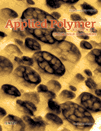Effect of coupling agent as integral blend additive on silicone rubber sealant
Abstract
Silane coupling agent (SCA) plays an important role in the improvement of adhesive properties of the silicone rubber (SR) sealant. In this study, three trifunctional silane coupling agents, (γ-aminopropytriethoxysilane (APTES), (γ-Glycidoxypropyl) methyldimethoxysilane (GDMMS), and 3-(Trimethoxysilyl)propyl methacrylate (MPS), were used as blend additive in SR, and the effect of silane coupling agents on the properties of SR was studied. The results showed that the bond strength of samples with different combination of APTES/GDMMS, GDMMS/MPS, or APTES/MPS, was significantly improved than those of single silanes. Silanes with polar group make contribution to the bond strength increase of SR sealant. The highest bond strength value (0.53 MPa) was obtained using the combination of APTES and GDMMS. The study of the samples with (APTES and GDMMS) showed that the bond strength and tensile strength of SR increase with the increasing amount of SCA. Further increase in the SCA content makes the bond strength and tensile strength of SR sealant decrease. The increase in the amount of SCAs makes the failure modes of samples convert from adhesive failure to cohesive failure. Tack-free time decreased linearly as the amount of SCA loading increased, while the hardness increased. It can be deduced that the trifunctional SCA has catalytic effect on the crosslinking action of SR sealant. © 2012 Wiley Periodicals, Inc. J. Appl. Polym. Sci., 2013




